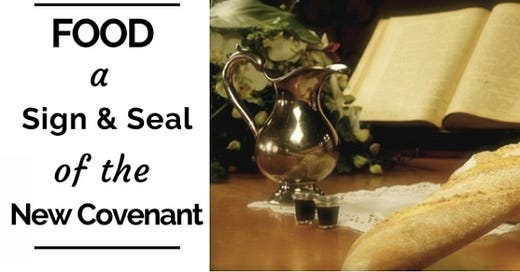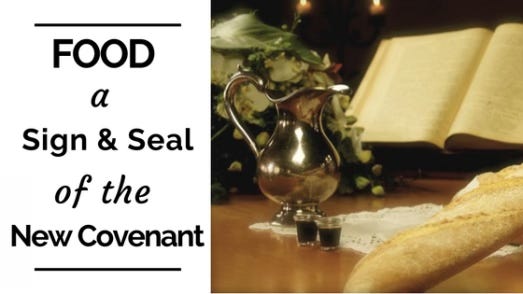This is part seven of a 10 part series titled 10 Ways Food Impacts History, Life, and the World.
Common for Holy
Have you ever wondered why God would choose common elements like bread and wine to represent something holy like a sacrament? According to the Westminster Confession of Faith, "sacraments are holy signs and seals of the covenant of grace" instituted by God as revealed in the Scriptures.
Sacraments
The Christian church has two biblical sacraments, baptism and communion.
Baptism is the sign and seal that we are washed from our sins and united to Christ into the covenant of grace. The sign is performed with water (washing) and represents the true baptism which is by the Spirit of God.
Communion, or the Lord's Supper, is the sign and seal of the New Covenant in Christ's blood, a symbol of the death of Christ for our sins.
The first element of Communion is a regular reminder of the body of Christ (His death for our sins) and is represented with a piece of common food, namely bread. And the blood He shed is represented by a common drink, namely wine.
Why would God chose common food and drink as the medium for something sacred?
The Bread
Bread has been one of the fundamental sources of human sustenance for most of history.
Genesis 3:9 is the first mention of bread in the Bible. "By the sweat of your face you will eat bread."
Genesis 14:18 is the second mention of bread. Here Melchizedek serves "bread and wine" to Abraham. Some commentators see this as an early picture of Communion.
Genesis 18:5 records a visit from the pre-incarnate Christ. Abraham desires to serve Him bread. And the Lord receives it and eats.
These are the first mentions of bread in the Bible, but they don't stop there. The word "bread" occurs 237 times in the Old Testament and 79 times in the New Testament. This does not include synonyms like "loaves," "loaf," "manna," "cakes," and the like.
One of the most important synonyms for bread occurs 17 times in nine different books of the Bible, six books in the Old and three in the New. This important bread was manna.
While the Israelites walked the wilderness for 40 years, God rained down manna (bread) from heaven to nourish His people. Later, Jesus said He was the "bread of life" which came down from heaven.
Hear it from Jesus' own words in John 6:48-51:
I am the bread of life. Our fathers ate the manna in the wilderness, and they died. This is the bread which comes down out of heaven, so that one may eat of it and not die. I am the living bread that came down out of heaven; if anyone eats of this bread, he will live forever; and the bread also which I will give for the life of the world is My flesh.
The sacrament of Communion reminds us that the death of Christ on the cross gives us spiritual life, just as bread gives physical life to the body while on this earth that God created. Manna (or bread) does not sustain a person into eternity, but Christ's flesh does.
The Wine
And the wine of Communion represents blood, which in a physical sense gives life to the flesh — according to Leviticus 17:11. But the wine doesn't only represent the blood of physical life, for the blood celebrated in Communion is the blood of the God-man, Jesus Christ. His blood is the only substance that can give life to our spiritual bodies.
And to add beauty to the sacrament, God chose wine as the element of Communion (not grape juice or another red drink). Wine speaks of the abundant life we can have temporally on earth and fully in eternity through the joy in the Holy Spirit. God gave wine to make man's heart glad (Psalm 104:15). He gave His blood to make man's heart overflowing with His delights unto eternity. In His right hand there are pleasures forever (Psalms 16:11).
Indeed food and drink are important to God. He established and ordained food as the means to nourish the body. And this very nourishment is a picture of the greater nourishment we have in Christ.
Next: The Food that Brings Judgment from the Almighty
Return to: Biblical Health Study



